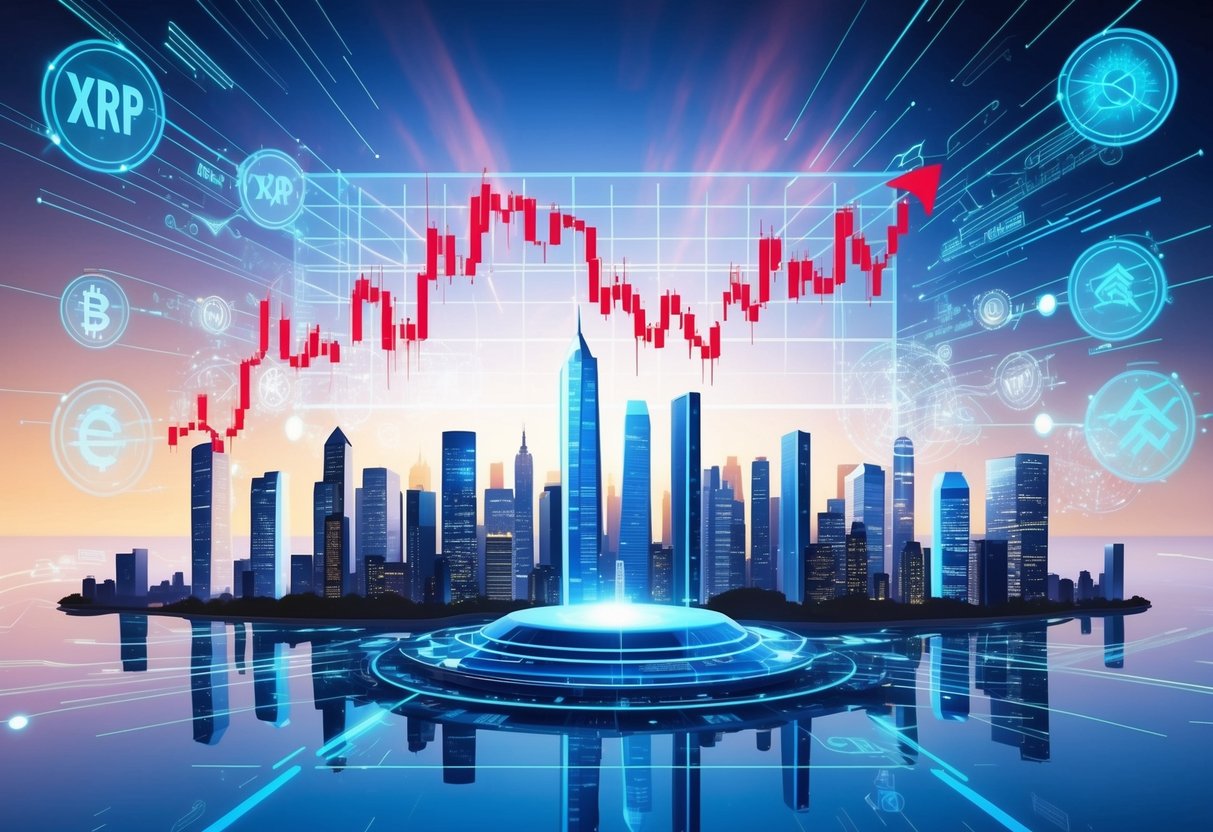XRP is one of the most discussed cryptocurrencies due to its unique technology and ongoing legal attention. Many investors are closely watching XRP’s price movements and predictions because it can be affected by several factors, including court decisions and changes in the global crypto market. XRP could reach prices between $27 and $120 in the near future according to analyst forecasts, with some long-term estimates suggesting it might achieve even higher values by 2040 (see more details at The Crypto Basic).

Predictions for XRP change as new information becomes available. Opinions from crypto analysts remain mixed, which makes it important for traders and investors to stay informed and careful. While XRP draws a lot of attention, new projects such as the Nollars Network presale are offering other investment opportunities that may interest those looking to diversify.
Key Takeaways
- XRP price forecasts suggest growth but remain uncertain due to regulation and market dynamics
- Legal decisions and changing sentiment strongly affect XRP predictions
- Exploring new projects like Nollars Network can offer different investment options
Understanding XRP and Its Role in Cryptocurrency
XRP is a digital asset created to work with modern payment systems. Its speed and low transaction costs help it stand out from many other cryptocurrencies.
What Is XRP?
XRP is a digital currency that supports fast and low-cost money transfers. It was designed by Ripple Labs to move value across the world quickly, making it useful for both individuals and businesses. Unlike Bitcoin, which relies on mining, all XRP tokens were created at once.
The use of XRP goes beyond just holding value. It acts as a bridge currency, letting banks or users exchange different types of money quickly. Many payment providers use XRP to save on transfer fees and avoid delays.
XRP is different from most cryptocurrencies because its supply is fixed, and it uses a unique way to validate transactions rather than traditional mining. This helps it keep transactions efficient and affordable.
XRP Ledger Technology
The XRP Ledger is the technology behind XRP. It is a blockchain-like system but is more focused on speed and efficiency. Instead of mining or proof-of-work, it uses a consensus protocol, where independent servers reach agreement on transactions.
Some key features of the XRP Ledger are:
- Fast settlement time (around 3-5 seconds)
- Low transaction cost (often less than a penny)
- Decentralized validation with trusted validators
The XRP Ledger can handle up to 1,500 transactions per second, much higher than Bitcoin or Ethereum. Its open-source design lets anyone use, improve, or build on it. The technology allows for creating tokens and running simple financial apps, expanding its use beyond just payments. You can learn more in this deep dive on Ripple’s XRP in blockchain and finance.
Ripple’s Vision and Influence
Ripple is the company behind XRP and its goal is to make global financial transactions easier. They want to connect banks, payment providers, and digital asset exchanges using XRP and the XRP Ledger.
Ripple has partnered with many financial institutions to help them use blockchain for cross-border payments. By using XRP, these institutions can move money quickly and reduce payment costs or errors. Ripple’s solutions focus on practical uses for blockchain, not just speculation.
The company’s vision has encouraged the use of digital currencies in real-world banking and payment systems. Ripple continues to work on expanding XRP’s role in the broader world of cryptocurrency and traditional finance.
Key Factors Influencing XRP Prediction
Several main factors shape XRP’s price outlook, including overall crypto market trends, how XRP compares with Bitcoin and Ethereum, and its use in payments and DeFi. These influences can cause XRP’s value to change quickly, making it important to watch developments closely.
Market Trends and Volatility
The global cryptocurrency market is very volatile. Quick price changes are common, as seen with sudden rises and drops. Investor mood, economic news, and regulatory updates all affect price swings.
Stable market conditions can help boost confidence among investors. Analysts have noted that when the market becomes steadier, there is a higher chance for XRP to rally, with some predictions pointing to a possible rise toward $3 if the overall climate stays positive. Read more about these forecasts in the Ripple price forecast.
Regulatory news, especially from countries with large crypto usage, also impacts XRP. Negative headlines or lawsuits can hurt prices, while positive news about legal clarity can help.
XRP Versus Bitcoin and Ethereum
XRP often moves in relation to Bitcoin and Ethereum. When Bitcoin or Ethereum rise, XRP sometimes follows because all three are among the top-traded coins. However, XRP has its own unique features.
Unlike Bitcoin, which is mainly used as digital gold, or Ethereum, which is known for smart contracts, XRP is focused on fast and low-cost payments. This distinction sets it apart in the eyes of investors and institutions.
Comparing historical price charts, XRP tends to be less volatile than some smaller coins but does not always move in sync with Bitcoin or Ethereum. Differences in adoption, technology, and use cases explain these moves.
Role of Payments and DeFi
XRP’s main use is in cross-border payments. Banks and payment providers use its network to move money quickly and cheaply. This strong use case attracts attention from big financial companies.
Growth in decentralized finance (DeFi) could impact XRP. While Ethereum has led in DeFi apps, efforts are being made to bring similar features to the XRP Ledger. If successful, this could add new reasons to hold or use XRP.
The ability of XRP to expand its role in payments and enter the DeFi space will likely play a big part in its future value. Opinions from experts suggest payment utility is a major reason for bullish speculation.
Regulatory Landscape and Its Impact on XRP
Legal and regulatory changes shape how XRP can be bought, sold, and used. The SEC’s actions and decisions by financial regulators worldwide play a key role in XRP’s market potential.
SEC Lawsuit and Regulatory Clarity
The U.S. Securities and Exchange Commission (SEC) filed a lawsuit against Ripple, claiming XRP was sold as an unregistered security. This lawsuit created confusion about the legal status of XRP in the United States.
As the suit moved through the courts, exchanges suspended or removed XRP trading. This limited investor access and slowed adoption. In 2023, a major ruling stated that some XRP transactions were not securities, which led to optimism among investors.
Regulatory clarity is critical for XRP’s future growth. If the courts or lawmakers confirm that XRP is not a security, U.S. exchanges could relist it. This development would likely boost market confidence and trading volume. For more information on recent developments see the Forbes outlook on XRP.
Global Regulatory Developments
While U.S. regulations impact XRP, many other countries are also shaping digital asset laws. Nations such as Japan and Switzerland have treated XRP as a digital token, not a security, supporting wider adoption there.
Pro-crypto frameworks in Europe, South America, and parts of Asia have made it possible for XRP to be used in banking and payment systems. These regulatory environments allow Ripple to partner with global financial institutions.
Recent moves in banking regulation and talks of launching XRP-related financial products continue to influence the token’s market. Clarity from more regulators can unlock new use cases and help stabilize its value. See more on how new rules may drive a potential XRP rally.
XRP Investment Opportunities and Market Sentiment
XRP continues to see new opportunities for investors as the cryptocurrency market expands. Recent developments in ETFs, digital assets, and institutional interest are shaping XRP’s outlook.
Spot XRP ETF and Spot ETFs
The possibility of a spot XRP ETF has become a leading topic in crypto investment discussions. Spot ETFs allow investors to buy shares that directly track the current market price of XRP, making it easier to gain exposure without owning the asset directly. If approved, a spot XRP ETF could attract a broader range of investors, including those who prefer traditional financial products over holding digital coins.
This potential product would likely increase overall demand for XRP. Bitcoin ETFs have already shown that spot ETFs tend to boost market liquidity and price stability. While a spot XRP ETF remains under review, anticipation alone has impacted trading behavior and increased attention from both retail and institutional buyers. For more details on how ETFs impact XRP, visit this XRP gains amidst crypto market recovery, futures ETFs approval report.
Institutional Investors and Strategic Reserve
Institutional investors are paying close attention to XRP, viewing it as a key player for global money transfers. Many large financial institutions, such as banks and payment companies, have tested or adopted Ripple’s technology to increase the speed and reduce the cost of cross-border payments.
Some institutions consider XRP as part of a strategic reserve for digital assets, aiming to diversify their portfolios and secure efficient transfer solutions. Greater institutional adoption could increase stability and long-term value for XRP. These moves signal confidence from larger entities, which could attract more traditional investors and bring extra legitimacy to the asset class.
NFTs and Digital Asset Expansion
The XRP Ledger has built-in support for NFTs, helping artists, creators, and brands mint and exchange unique digital assets efficiently. XRP’s fast settlement and low fees make it a competitive alternative for NFT transactions compared to other blockchains.
As the NFT space grows, more developers and projects are exploring the XRP ecosystem to create unique tokens, digital art, gaming assets, and collectibles. This expansion is fueling broader use of the XRP Ledger beyond payments, helping XRP stay relevant in the evolving digital assets landscape and encouraging more development activity around its blockchain platform.
Future Outlook for XRP Prediction
XRP’s future value depends on factors such as market trends, regulatory changes, and the adoption of Ripple’s technology. Both short-term shifts and longer-term goals should be evaluated to understand its full potential and risks.
Short-Term and Long-Term Forecasts
In the short term, XRP’s price may face ups and downs due to ongoing market volatility and the impact of regulations. For example, some analysts expect a decrease in price by late April 2025, with predictions suggesting a possible drop of around 5% during that period.
Looking further out, long-term forecasts for XRP are mixed but offer more optimistic possibilities. By 2030, some projections expect XRP to reach near $3 or even rise to around $2.91 based on current analyses. Other estimates go even higher by 2040, but these are less certain and depend on widespread adoption and the cryptocurrency market as a whole. Historical trends and market cycles suggest XRP’s future performance will rely heavily on how Ripple’s technology is used in real-world financial systems.
| Year | Price Estimate (USD) |
|---|---|
| 2025 | $2.28 |
| 2029 | $3.94 |
| 2030 | $2.91 |
Potential Challenges and Growth Drivers
One of the main challenges for XRP is the uncertain regulatory environment, especially as governments increase oversight of digital currencies. Legal outcomes, such as court decisions about whether XRP is a security, strongly influence its price and adoption.
At the same time, Ripple’s partnerships with banks and financial companies stand out as a key growth driver. Wider acceptance of Ripple’s payment technology could increase demand for XRP. However, competition from other cryptocurrencies and changes in investor sentiment can also affect growth. Adoption by new markets and real-world use cases may support steady long-term growth for XRP if regulatory concerns are resolved and the network continues to expand.
Frequently Asked Questions

XRP price predictions come from crypto analysts, market trends, and recent legal news. Forecasts can vary a lot depending on timeframes, regulations, and new developments.
What are the projected price predictions for XRP in the coming years?
Crypto analysts expect XRP to show steady but not extreme growth in the next few years. For example, predictions for 2025 and 2030 show different ranges based on events and adoption. Many forecasts expect slow increases with some reaching several dollars per coin.
What could be the future value of XRP by 2025?
Estimates for 2025 place XRP between about $1.90 and $5. Some analysts suggest it may average between around $3.5 to $5 depending on market and legal factors. Others predict it may stay closer to between $1.90 and $2.05 during that year.
How might the outcome of the lawsuit affect XRP’s price?
If Ripple wins its ongoing lawsuit, XRP’s price could get a boost from more investor confidence and potential listings on big exchanges. On the other hand, a negative outcome could lead to lower demand. Legal clarity is expected to be a major driver for XRP’s future value.
What is the potential high of XRP’s value in 2030?
Analyst estimates for 2030 vary, but some projections see a minimum of about $6.76 and a maximum nearing close to $180 if there is strong adoption and favorable conditions. Most expect the value to stay in a lower range unless major changes happen in the crypto market.
Could XRP’s value ever reach $100?
Some long-term predictions suggest XRP could possibly reach $100, but this would require major changes in market demand and global adoption. Most experts consider this to be very difficult under current conditions, so it is seen as unlikely in the near future.
Are there any predictions for XRP’s price by 2040?
Long-term forecasts for 2040 are highly speculative. Some analysts predict a minimum price of about $6.76, while the maximum could reach close to $180, depending on technology adoption and regulations. Most projections suggest moderate growth rather than dramatic increases.




